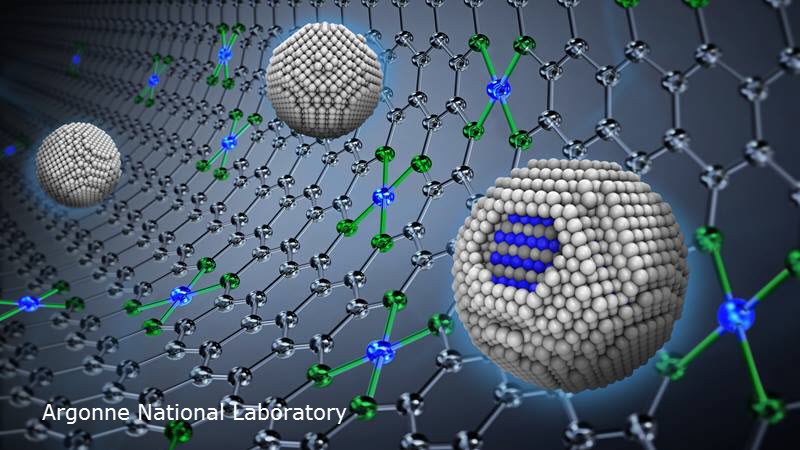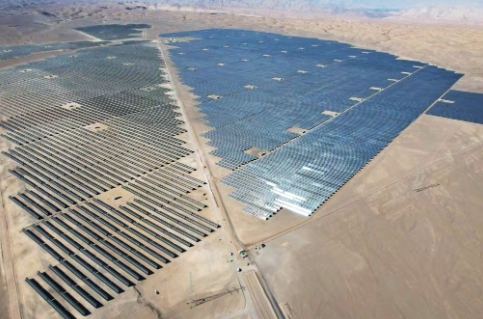 An artistic rendition of the synergistic catalyst showing core-shell active sites (blue) in platinum-cobalt nanoparticles (spheres) on a platinum group metal-free catalytic support.
An artistic rendition of the synergistic catalyst showing core-shell active sites (blue) in platinum-cobalt nanoparticles (spheres) on a platinum group metal-free catalytic support.
A new catalyst design meets cost, activity, and durability goals by leveraging ultralow loadings of platinum with platinum-free supports.
The Science
Scientists have identified highly active yet stable catalysts for use in fuel cells that contain only a quarter of the platinum as compared to existing devices. Platinum is essential for promoting reactions in these fuel cells. However, the precious metal is rare and expensive. Interactions between platinum-cobalt particles and a precious metal-free support contribute to the improved performance.
The Impact
Proton-exchange membrane fuel cells (PEMFCs) are highly efficient. They represent a future powertrain for light and heavy-duty vehicles. A widespread transition from combustion engines to fuel cells in the automotive industry requires lower costs of materials and improved fuel cell performance. The catalysts identified in this study use a significantly lower amount of platinum, thus reducing cost. The new material also exceeds multiple 2025 DOE targets for fuel cells performance.
Summary
Innovative approaches for reducing the amount of platinum in catalysts, while maintaining the high activity and stability that platinum provides, are of intense interest. The costly metal currently plays a crucial role in catalyzing multiple reactions in PEMFCs, including the breakdown of oxygen to form water. Scientists at Argonne National Laboratory’s Center for Nanoscale Materials (CNM), a DOE Office of Science user facility, are working with scientists and engineers at Argonne, Purdue University, and Shanghai Jiao Tong University to advance this research. After the team created the catalysts, the team characterized them using CNM’s aberration-corrected, high-resolution transmission electron microscope and spectroscopy capabilities at Argonne’s Advanced Photon Source, and modeled using CNM’s Carbon, a high-performance computing cluster. Together the team developed a synergistic catalytic system that involves platinum-cobalt nanoparticles and a platinum-group-metal-free (PGM-free) substrate.
The synthesis involves converting a cobalt-containing porous metal-organic framework to a catalytically active substrate containing cobalt, nitrogen, and carbon decorated by nano-sized metallic crystallites, and then adding platinum to form platinum-cobalt nanoparticles with a core-shell structure that is confirmed by electron microscope measurements. These catalysts contain only about 3% of platinum by weight, in contrast to commercial fuel cell catalysts that contain 20% to 30% of platinum. The team evaluated the catalyst performance in operating PEMFC conditions. The results show significantly improved catalytic activity (with values of 1.08 to 1.77 A mgPt-1, exceeding the 2025 Department of Energy target of 0.44 A mgPt-1) and durability (retaining up to 64% of initial values after 30,000 voltage cycles). Computational modeling revealed the interaction between platinum-cobalt nanoparticles and PGM-free sites contribute to the improvements.
Contact
Jianguo Wen
Center for Nanoscale Materials and Argonne National Laboratory
jwen@anl.gov; (630) 252-3254
Maria K. Chan
Center for Nanoscale Materials and Argonne National Laboratory
mchan@anl.gov; (630) 252-4811
Di-Jia Liu
Argonne National Laboratory
djliu@anl.gov; (630) 252-4511







